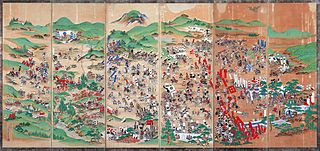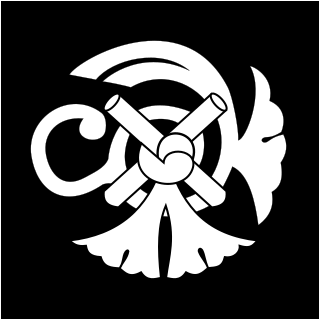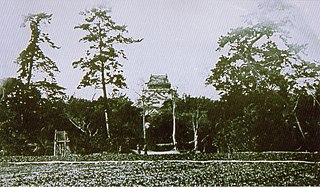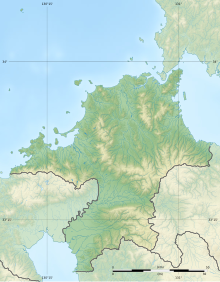
The Battle of Sekigahara, was an important battle in Japan which occurred on October 21, 1600 in what is now Gifu Prefecture, Japan, at the end of the Sengoku period.
The siege of Ōtsu took place in 1600, concurrent with the battle of Sekigahara. Kyōgoku Takatsugu held Ōtsu castle for the Tokugawa, and commanded the garrison.

The siege of Osaka was a series of battles undertaken by the Japanese Tokugawa shogunate against the Toyotomi clan, and ending in that clan's destruction. Divided into two stages, the winter campaign and the summer campaign, it lasted from 1614 to 1615. The siege put an end to the last major armed opposition to the establishment of the Tokugawa shogunate. The end of the conflict is sometimes called the Genna Armistice, because the era name was changed from Keichō to Genna immediately following the siege.

Date Tadamune was an early Edo period Japanese samurai, and the second daimyō of the 625,000 koku Sendai Domain in the Tōhoku region of northern Japan. He was the half-brother of Date Hidemune of Uwajima Domain.

Nabeshima Naoshige was a warlord of the Sengoku and early Edo periods and progenitor of the Nabeshima lords of the Saga Domain. Naoshige was the second son of Nabeshima Kiyofusa. His mother was the daughter of Ryūzōji Iesumi. He was a vassal of the Ryūzōji clan during the Sengoku period of the 16th century.
The Sekigahara Campaign was a series of battles in Japan fought between the Eastern Army aligned with Tokugawa Ieyasu and the Western Army loyal to Ishida Mitsunari, culminating in the decisive Battle of Sekigahara. The conflict was sparked by a punitive expedition led by Ieyasu against the Uesugi clan in the northeastern Tōhoku region, providing Mitsunari with an opportunity to denounce Ieyasu in the name of the infant ruling taikō Toyotomi Hideyori while the Tokugawa troops were in the field.

The Tachibana clan (立花氏) was a Japanese clan of daimyō during Japan's Sengoku and Edo periods. Originally based in Tachibana castle in Kyūshū, the family's holdings were moved to the Yanagawa Domain in the far north-east of Honshū in the Edo period.

Tachibanayama Castle was a Japanese castle in Chikuzen Province, in the north of Kyūshū. It was at the peak of Mount Tachibana, extending in part into the Higashi-ku in Fukuoka. The castle is also known as Rikka-jō, Tachibana-jō, or Rikkasan-jō.

Tachibana Ginchiyo was head of the Japanese Tachibana clan and onna-musha during the Sengoku period. She was a daughter of Tachibana Dōsetsu, a powerful retainer of the Ōtomo clan. Because Dosetsu had no sons, he requested that Ginchiyo be made family head.

The Owari-Han, also known as the Owari Domain, was a significant feudal domain in Japan during the Edo period. Situated in the western region of what is now Aichi Prefecture, it covered portions of Owari, Mino, and Shinano provinces, with its central administration based at Nagoya Castle. At its zenith, the Owari Domain boasted an impressive rating of 619,500 koku, making it the largest landholding of the Tokugawa clan outside of the shogunal territories. The ruling clan of the Owari Domain was the Tokugawa clan, holding the prestigious position of the highest rank among the gosanke. Additionally, the domain was sometimes referred to as the Nagoya Domain due to its association with Nagoya Castle.

Tanagura Domain was a fudai feudal domain under the Tokugawa shogunate of Edo period Japan. It is located in southern Mutsu Province, Honshū. The domain was centered at Tanagura Castle, located in what is now part of the town of Tanagura in Fukushima Prefecture.

Yanagawa Domain was a feudal domain under the Tokugawa shogunate of Edo period Japan, in what is now eastern Fukuoka Prefecture. It was centered around Yanagawa Castle in what is now the city of Yanagawa, Fukuoka and was ruled by the tozama daimyō Tachibana clan for much of its history.

Tachibana Muneshige, was a Japanese samurai, known in his youth as Senkumamaru (千熊丸) and alternatively called Tachibana Munetora, during the Azuchi–Momoyama period and an Edo-period daimyō.

Sengoku Basara: End of Judgement is an anime television series based on the Sengoku Basara games originally created by CAPCOM. It began airing on July 6, 2014 on NTV and tells its own version of the story from the video game Sengoku Basara: Samurai Heroes.

Aoi is a 2000 Japanese historical drama television series and the 39th NHK taiga drama. The series respectively stars Masahiko Tsugawa, Toshiyuki Nishida, and Onoe Tatsunosuke II as the first three Tokugawa shōguns. It aired from January 9 to December 17, 2000, and ran for a total of 49 episodes.

Tanagura Castle a flatland-style Japanese castle located in the town of Tanagura, Tamura District, Fukushima Prefecture, in the southern Tōhoku region of Japan. It also called Kamegajō Castle (亀ケ城). Built in 1625 by Niwa Nagashige, the castle was occupied by a succession of daimyō of Tanagura Domain under the Edo period Tokugawa shogunate.

Fukugon-ji (福厳寺) is an Ōbaku Zen temple in Yanagawa, Fukuoka, Japan. Its honorary sangō prefix is Baigakuzan (梅岳山).

Zendō-ji (善導寺), also called DaihonzanZendō-ji is a Jōdo-shū Buddhist temple in Kurume, Fukuoka Prefecture, Japan.

















